Basketball Offense - Thunder Offense
From the Coach’s Clipboard Basketball Playbook"Helping coaches coach better..."

Contributed by Coach Thomas J. Koeller,
Southwestern High School, Hazel Green, WI
This is our "Thunder" motion offense, which is a variation of flex offense.
Diagram A. Initial Setup of the Thunder Offense
Keys to remember in this step:Spacing - O3 must not setup too deeply outside.
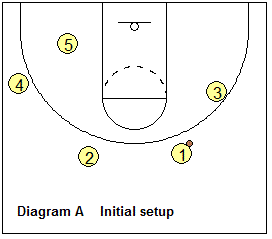
Diagram B. Step One (First movement and ideal shot)
Keys to remember in this step:1. O3 must get open for pass from O1 to start the play. Use a v-cut.
2. O4 cuts only when pass is thrown from O1 to O3.
3. O5 MUST set a good pick for cutter, and cutter, use O5's pick.
4. O3 then passes to O4 on the block if O4 is open.
5. O4 turnaround jump shot, kiss off of the glass.
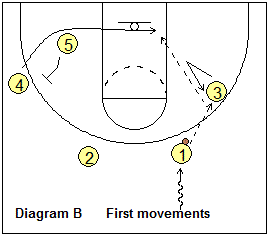
Diagram C. Step Two (Pass or shot not open to O4 on cut)
Now we motion to new set.Keys to remember in this step:
1. O3 immediately passes back to O1.
2. O2 down-screens for O5 who comes up to replace him/her.
3. O2 then moves out to the wing.
4. We are now in the original formation just on the other side.
5. O1 passes to O5 (now the other guard).
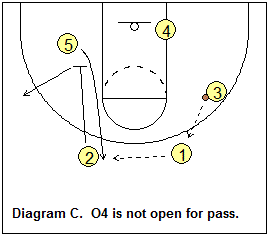
Diagram D. Original setup from opposite side (The result of first rotation).
Key points to remember in this setup:1. O5 is now essentially the point guard.
2. Spacing should remain the same as the original set. Get to the correct spot on the floor.
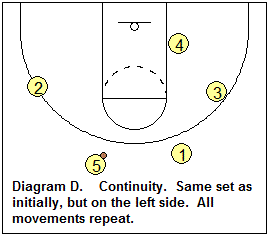
Diagram E. Step One (First movement and ideal shot)
Keys to remember in this step:1. O2 must get open for pass from O5 to start the play. Use a v-cut.
2. O3 cuts only when pass is thrown from O5 to O2.
3. O4 MUST set a good pick for cutter and cutter uses O4's pick.
4. O2 then passes to O3 on the block if O3 is open.
5. O3 turnaround jump shot, kiss off of the glass.
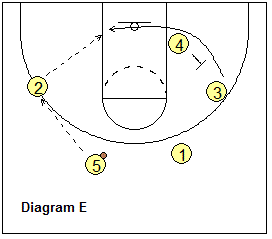
Diagram F. Step Two (Pass or shot not open to O3 on cut)
Now we motion to new set.Keys to remember in this step:
1. O2 immediately passes back to O5.
2. O1 down-screens for O4 who comes up to replace him/her.
3. O1 then floats out to the wing.
4. We are now in the original formation just on the other side.
5. O5 passes to O4 (now the other guard).

This offense can be rotated an infinite number of times. After 5 rotations, everyone is back in their original position, only on the opposite side (i.e. O1 is point again, and O5 is setting the screen again). After 10 rotations, you are back to the very first setup.
This offense can be difficult to learn at first. Patience, timing, and repetition will end the frustration of learning this offense and increase the frustration experienced by the opponent trying to defend it.
After mastering this offense, many things can be done out of it to keep the defense guessing. The scoring options that are available from this offense are nearly impossible to stop even by a team that knows exactly how to run it themselves.
For example, if the defense is getting used to the pass to the wing and begins cheating out, the wing needs to signal to the point guard that instead of v-cutting, he/she will be back-cutting to the basket for a quick pass.
Another option is to cut at the middle block or the elbow if a "cheating" defender is filling the low post. Also, be sure to know what to do if the point guard picks the left side. If this happens we simply move O4 out to the wing on that side and shift O5 to the other block and make O3 the first cutter.
More than anything, if the screens are good and the passes are crisp, after a few motions you will always get a shooting window. If this offense begins failing to produce points there are some keys to it that are likely being neglected that must be practiced or re-learned.